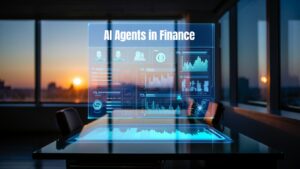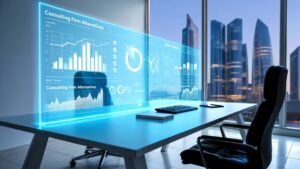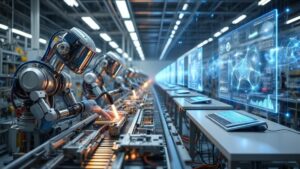Imagine a retail store preparing for the holiday season, only to find its shelves overflowing with unsold items while other high-demand products are out of stock. This scenario is not uncommon. Research studies show that businesses worldwide lose billions of dollars annually due to forecasting inaccuracies. Overstocking ties up valuable capital and storage space, while understocking leads to missed sales opportunities and dissatisfied customers.
These challenges are amplified as markets become more dynamic, with fluctuating consumer behaviors and unpredictable external factors.
This article will uncover AI demand forecasting benefits and how they address common business challenges. We’ll also highlight AI demand forecasting use cases that illustrate its transformative potential. By the end, you’ll clearly understand why adopting AI in this space is no longer optional but essential for staying competitive in today’s market.
Introducing AI in Demand Forecasting
Enter AI in demand forecasting—a modern approach powered by machine learning and advanced data analysis. Unlike older systems that primarily rely on past trends, AI-driven tools integrate multiple data streams, including real-time market changes, weather patterns, and even social media activity. This sophisticated approach enables businesses to make faster, more informed decisions, staying ahead of competitors and customer expectations.
By utilizing artificial intelligence, businesses can move from static predictions to dynamic, continuously improving forecasts. This is no longer a luxury reserved for tech giants but a practical solution for companies of all sizes aiming to enhance their decision-making and operational efficiency.
How AI Demand Forecasting Works
AI demand forecasting is an advanced process that improves how businesses predict future customer demand. Unlike older methods, AI uses smart algorithms to study large amounts of data and provide more accurate predictions. Let’s explore how this process works step by step.
Machine Learning Algorithms
At the heart of AI demand forecasting are machine learning algorithms. These computer programs can learn from data and improve their predictions over time. They start by analyzing patterns in past information, such as sales records, inventory levels, and purchasing trends.
For example, if a store has records showing that ice cream sales increase during summer, the algorithm identifies this as a trend. However, what makes AI special is that it doesn’t stop there. It also considers other factors, such as upcoming weather forecasts or promotional events, to make even more precise predictions.
Machine learning adapts over time, so if something unexpected happens—like a new competitor entering the market or a change in customer preferences—the system learns and adjusts its predictions automatically. This ability to adapt makes AI stand out compared to older forecasting methods.
Data Integration
AI doesn’t rely on just one type of data. Instead, it gathers and combines information from many different sources. This makes the predictions more accurate and reliable. For example:
- Sales Data: Helps AI understand past demand trends.
- Market Trends: Provides insights into what is currently popular or in demand.
- Weather Conditions: Allows businesses like clothing retailers or ice cream shops to prepare for seasonal shifts.
- Social Media Sentiment: Tracks what customers are saying online about products or trends, giving a real-time view of public interest.
By merging all these different types of data, AI creates a more complete picture of what the future might look like. This integration is key to helping businesses stay prepared and make better decisions.
Real-Time Analysis
Traditional forecasting methods often take time to analyze data, which can cause delays in decision-making. AI changes this by working in real-time. This means it processes data and updates predictions as new information comes in.
For instance, if a company launches a new product and sees an unexpected surge in online mentions or sales, AI immediately adjusts its forecast to reflect this change.
This quick response allows businesses to take action right away, such as increasing production or ordering more supplies.
Real-time analysis is especially valuable in industries like e-commerce or supply chain management, where even small delays can lead to lost opportunities or wasted resources.
Additionally, AI can process data in different languages or currencies, making it a valuable tool for businesses expanding internationally. This adaptability helps companies remain competitive no matter how large or complex their operations become.
5 Ways AI Demand Forecasting Can Boost Your Business
Enhanced Accuracy and Precision
AI in demand forecasting has significantly improved the ability to make precise predictions. Traditional methods often rely heavily on past data and simple statistical calculations, leading to frequent errors, especially when dealing with complex market behaviors. With advanced technologies, businesses can now analyze vast and diverse datasets, including real-time information like social media trends, weather, or economic indicators. This allows organizations to predict demand with unparalleled precision.
For instance, in the retail sector, accurate predictions ensure that shelves are stocked with items customers want, reducing both surplus inventory and lost sales opportunities. In industries such as food supply chains, AI demand forecasting use cases include minimizing perishable waste by aligning production and supply more closely with actual demand. By cutting down inaccuracies, businesses save money and build trust with their customers by meeting their needs consistently.
Improved Inventory Management
Optimizing inventory is another area where AI demand forecasting benefits are clear. Maintaining the right stock levels has always been a delicate balance for businesses. Overstocking can lead to high holding costs, while stock outs result in lost sales and dissatisfied customers. Companies can use AI-powered tools to monitor demand patterns and predict fluctuations well in advance, ensuring their inventory is always optimized.
For example, a clothing retailer might use these systems to anticipate seasonal trends, ensuring that popular items are in stock during peak seasons. Similarly, a pharmaceutical company can manage supplies more effectively by predicting spikes in demand for certain medications. These practical applications of AI demand forecasting use cases help businesses reduce costs, improve operational efficiency, and enhance customer satisfaction.
Agility in Responding to Market Trends
Markets are dynamic and can shift rapidly due to economic changes, global events, or evolving consumer preferences. Traditional forecasting methods often fail to keep up with these sudden changes. In contrast, AI in demand forecasting excels at identifying emerging trends quickly and adapting predictions accordingly.
Consider how a grocery chain can use AI to respond to sudden demand for staple goods during an unexpected event, such as a weather-related disruption. Similarly, an e-commerce platform might rely on these insights to adjust its offerings in real-time during shopping holidays like Black Friday. This agility helps businesses remain competitive and prevents losses from unsold goods or missed opportunities.
Cost Efficiency and Operational Savings
Accurate predictions from AI demand forecasting benefit businesses by reducing waste and optimizing resource allocation. Companies can streamline their supply chains, reduce unnecessary expenses, and maximize profits by knowing exactly what is needed and when. This holds across a variety of industries, from manufacturing to logistics.
In the manufacturing sector, precise forecasting can ensure that raw materials are ordered correctly, reducing surplus and storage costs. In logistics, AI helps optimize delivery schedules, ensuring that resources like fuel and labor are used efficiently. These improvements save money and reduce environmental impacts, aligning with sustainability goals.
Improved Customer Satisfaction and Experience
One of the most valuable outcomes of AI demand forecasting use cases is the enhanced experience it provides for customers. Businesses can fulfill customer expectations more effectively by ensuring that the right products are available at the right time. This reliability fosters loyalty and encourages repeat business.
Personalized marketing is another advantage. By analyzing purchasing behavior, AI tools can predict what individual customers might need next, enabling companies to provide customized recommendations. For example, an online bookstore might suggest titles based on previous purchases, creating a more engaging shopping experience. These applications demonstrate how businesses can build stronger customer relationships through thoughtful, data-driven decisions.
Real-World Examples of AI Demand Forecasting in Action
1. Amazon
Amazon pioneered using AI-driven demand forecasting to optimize its supply chain and inventory management. Amazon can predict demand with incredible accuracy by analyzing customer browsing habits, historical purchasing patterns, local weather, and regional trends.
This allows the company to stock the right products in the correct quantities at fulfillment centers across the globe. Additionally, its AI systems help manage dynamic pricing strategies and ensure fast delivery, contributing to a seamless customer experience.
For example, during peak seasons like Black Friday or Prime Day, Amazon uses its AI models to anticipate spikes in demand for specific categories and adjusts inventory and logistics in advance. This proactive approach reduces delays, prevents stockouts, and keeps customers satisfied.
2. Zara
Zara, a global leader in fast fashion, leverages AI forecasting to stay ahead of changing fashion trends. The company collects data from various sources, including customer feedback, point-of-sale transactions, and even social media trends, to understand what products are gaining popularity. This data-driven approach allows Zara to adjust its production and distribution processes in real-time.
For instance, if a particular design sells out quickly in one region, Zara’s AI systems identify the trend and prioritize restocking that item in high-demand areas. This agile system minimizes excess inventory, shortens product cycles, and ensures customers can access the latest styles without delays.
3. Walmart
As one of the largest retail chains in the world, Walmart relies heavily on AI demand forecasting to manage its vast inventory. Walmart’s AI systems analyze billions of data points, including historical sales, regional buying behavior, weather forecasts, and local events, to accurately predict product demand across its stores.
During hurricane season, for example, Walmart uses its AI tools to forecast demand for emergency supplies like bottled water, batteries, and canned goods. By preemptively stocking these items in stores in affected areas, Walmart ensures it meets customer needs while avoiding overstocking elsewhere. This precision improves operational efficiency but also strengthens customer trust.
The Future of AI Demand Forecasting
Advancements in Technology
The future of demand forecasting lies in further technological advancements. Predictive analytics is becoming increasingly sophisticated, capable of identifying even the most subtle trends in large datasets.
With the integration of IoT devices, businesses can now receive real-time updates from their supply chains, such as stock levels or production rates, enabling even more precise forecasting. Edge computing, which processes data closer to its source, is enhancing the speed and efficiency of forecasting systems, making insights available instantly without relying on centralized cloud servers.
Broader Adoption Across Industries
While retail and logistics have already seen significant benefits from AI forecasting, other sectors are beginning to adopt this technology. In healthcare, demand forecasting helps manage the supply of critical medicines and hospital equipment. AI analyzes weather patterns and crop cycles in agriculture to predict yield, enabling better resource allocation. Similarly, the energy sector uses AI to anticipate fluctuations in energy consumption and adjust supply accordingly, reducing waste and ensuring reliability.
Ethical Considerations and Responsible Use
As AI demand forecasting continues to evolve, businesses must address ethical concerns. Ensuring data privacy is paramount, especially when using customer data for predictions. Additionally, businesses need to minimize biases in AI models to avoid skewed predictions that could harm certain demographics. Transparent practices and regular audits of AI systems are essential to maintain trust and ensure fair use.
Steps to Implement AI Demand Forecasting in Your Business
Assess Your Business Needs
Before adopting AI forecasting, evaluate which areas of your operations would benefit most. For example, if your business struggles with inventory shortages, start there. Understanding your pain points will guide the implementation process and help prioritize goals.
Select the Right Tools
Numerous AI tools and platforms are available for demand forecasting. Research a solution that aligns with your business size, industry, and budget. Some popular options offer customizable features, while others provide ready-to-use solutions for small businesses.
Prepare Your Data
AI systems rely on high-quality data to generate accurate forecasts. This means cleaning and organizing your data sources, such as sales records, customer feedback, and supply chain metrics. Ensure that your data is up-to-date and free from inconsistencies to maximize the effectiveness of your AI system.
Start Small and Scale Gradually
To test its performance, begin by implementing AI forecasting in a specific area or department. For instance, a pilot program in inventory management can help identify any challenges before expanding to other places. As you gain confidence in the system’s accuracy and efficiency, scale it across your business.
The Business Impact of AI Demand Forecasting
AI demand forecasting offers businesses a powerful tool to improve decision-making, enhance efficiency, and meet customer expectations. By analyzing data more accurately, businesses can avoid the pitfalls of traditional forecasting methods, such as overstocking or missed opportunities. This leads to cost savings and a more streamlined and customer-centric operation.
Now is the time to explore how AI demand forecasting can benefit your business. With tools readily available and technology advancing rapidly, adopting this approach will help you stay competitive and adapt to changing market demands.
FAQs and Common Misconceptions
Is AI demand forecasting expensive?
While the initial investment might seem high, the long-term savings from reduced waste and better resource allocation often outweigh the costs. Scalable solutions are available, making it accessible even for smaller businesses.
How does AI handle unpredictable events like COVID-19?
AI systems are designed to adapt to new data quickly. They analyze emerging trends and adjust predictions during unforeseen events, helping businesses respond faster than traditional methods.
Can small businesses benefit from AI demand forecasting?
Absolutely. Many AI tools are now designed with scalability in mind, offering affordable solutions for smaller enterprises. Small businesses can experience immediate improvements and expand their usage over time by starting with a specific use case.
Looking to improve your business operations with smarter demand planning? RTS Labs helps companies see the full potential of AI in demand forecasting. We provide solutions to enhance accuracy and efficiency, from customized strategies to advanced tools. Get in touch today to learn more about AI demand forecasting use cases and how they can benefit your business!
Further Reading
To deepen your understanding of AI in demand forecasting and its impact on businesses, here are some recommended books:
- “Prediction Machines: The Simple Economics of Artificial Intelligence” by Ajay Agrawal, Joshua Gans, and Avi Goldfarb
This book explains how AI simplifies decision-making processes and provides actionable insights for businesses looking to implement AI-based forecasting. Buy on Amazon
- “Artificial Intelligence in Practice: How 50 Successful Companies Used AI and Machine Learning to Solve Problems” by Bernard Marr
Featuring real-world applications of AI across industries, this book provides practical examples of how businesses use AI, including demand forecasting, to gain a competitive edge. Buy on Amazon
- “Big Data: A Revolution That Will Transform How We Live, Work, and Think” by Viktor Mayer-Schönberger and Kenneth Cukier
This book explores the growing importance of big data and its role in improving business operations, such as forecasting and resource allocation. Buy on Amazon







